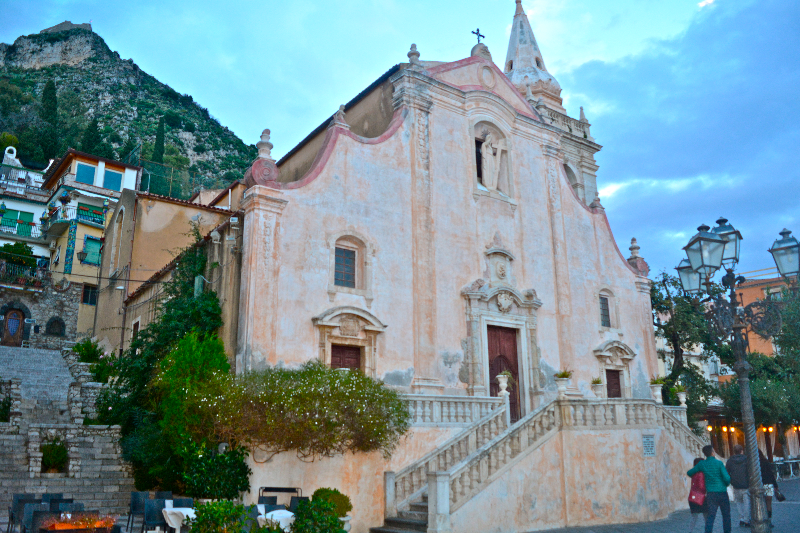It is lined with the predominantly gently tinted white limestone buildings of the many ages and cultures that have invaded the island. Classical, medieval, renaissance and even baroque, styles constitute a virtual encyclopedia of architecture through the ages. The heritage is immaculately maintained, and actively in use for small businesses and commerce, while the streets and piazzas are proudly festooned and garlanded with a colourful array of flowers. It is a sheer delight that these days unfortunately endures and it must be said, prospers, from the inevitable over-commercialization of mass tourism. They all came, they saw, they paid…and then they left.
We sat in the warm late autumn evenings on our terracotta paved terrace high above the wonderful sparkling waters of Castellamare Bay with its dazzling aquamarine hues, under a vast pellucid sky, sipping on our aperitifs of orange coloured and flavoured Aperol Spritz and rose wine, and munching on the delicious local salamis, olives and cheeses. It is easy to fall under a certain spell of enchantment. Looming high above us to our far right was the smoking cone of Mount Etna the highest active volcano in Europe, immediately above us lay the medieval, crenellated walls of Castellamare, while behind and to our left nestled the wondrous remains of the Greco-Roman theatre possessed of surely the finest setting ever for such a venue. Immediately below lay the terraced public garden Giardini-Naxos with its sweeping views over the sun-bathed water and to a delightful design of topiary, flowers, trees, ponds and follies. Sometimes called the Trevelyan Gardens it was laid out in the English style in the late nineteenth century complete with small ‘follies’.

Limestone buildings
Lawrence wrote in Sea and Sardinia: “Etna, like a white queen, or a white witch, standing there in the sky; so magically beautiful, but I think wicked”. When he arrived in 1920 he read and was enchanted by the writings of the preeminent novelist of the region, the realist writer, Giovanni Verga (1840-1922) and fascinated by his spare and concise language. He set to translating Verga’s works while in Taormina. Verga provided brutal details of local peasant lives dominated by toil and poverty but redeemed by spontaneous vitality, themes shared in Lawrence’s own works.
‘a glossy sheen of glamour’
Taormina is proud of its artistic and literary heritage as a famous watering hole for visiting European and American celebrities over the decades. There are signs at various locations displaying photos of many of them in the haunts they frequented. The brochures sparkle with celebrity names, from the days of the European ‘grand tour’ in the late nineteenth century when Taormina was ‘discovered’ by the glitterati of the day, including, Goethe, Dumas, Wilde, Wagner, Brahms, Klimt... Latterly came the Hollywood stars, directors, writers and jet set, including Capote, Hemmingway, Tennessee Williams, Richard Burton, Elizabeth Taylor, Marcello Mastroianni, Ingmar Bergman, Cary Grant, Francis Ford Coppola, Marlene Dietrich, Greta Garbo, Frederico Fellini, Woody Allen….
Taormina has always had about it that ‘glossy sheen of glamour’ that reflected the epithet ‘the pearl of the Mediterranean’. There is a large café plastered with photos and names of celebrity visitors. The grandest hotel in town, perched on a high point overlooking the sea at the far end of the town and next to the Greco-Roman theatre site, closed for the off season when we were there, is marketed as the place for the in-crowd and is redolent with luxury viewed even from the outside. In season Taormina hosts a dazzling array of cultural festivals, such as, film festival held for the past 60 years in the Greco-Roman theatre each June, the literary Tao Book festival each September, and the annual Tao Arte.
‘A nice big house at some distance above the sea’
Jill and I confidently set out on another bright sunny morning to find Villa Fontana Vecchia. Having read Lawrence’s description our expectations were fuelled : ‘a nice big house, with fine rooms and a handy kitchen, set in a big garden, mostly vegetables, green with almond trees, on a steep slope at some distance above the sea. It is beautiful, and green, green and full of flowers’.
We were armed with a local tourist map that to our delight showed a clearly marked Via David Herbert Lawrence further on up the hill just outside the old town walls. Surprisingly however, the map, which marked the locations of houses lived in by visiting celebrities and writers, carried no indication of Lawrence’s house. In any event, this promised to be a lot easier an assignment than trying to track down the farm outside Taos which we did find in due course, obligingly signposted by the University of New Mexico that now owns it; or his cottage in the small Cornish village of Zennor which eluded us completely; or indeed his rented house ‘Wyewurk’ on the clifftops above the beach at Thirroul on the south coast out of Sydney, that we did
continued over page